World Health Day: The Overlooked Health Risks of Climate Change
07.04.2025
Let's talk about cold-related deaths, spreading diseases, and air pollution!
07.04.2025
Let's talk about cold-related deaths, spreading diseases, and air pollution!

Climate change is not just an environmental crisis—it’s a health crisis. Rising temperatures, changing weather patterns, and shifting ecosystems directly and indirectly impact human health.
We often hear about heatwaves and their deadly toll, but climate change also influences infectious diseases, water quality, food security, and even cold-related mortality. Some risks are increasing, while others—like deaths from extreme cold—are actually decreasing in certain regions. At the Nexus Research Group, we explore these issues to better understand how climate change is reshaping health risks—and how we can adapt.
On this World Health Day, we want to present three studies that our colleague Dr. David Gampe was involved in and that shed light on critical aspects of climate and health that go beyond the usual discussion:
Cold-Related Deaths: A Declining Trend Amid Rising Temperatures
What happens to cold-related deaths as the planet warms? While we mostly hear about the dangers of heat waves, our study on mortality trends in London (1976–2019) highlights a lesser-known trend: a decline in cold-related deaths.
Key Takeaways:
This challenges the oversimplified narrative that a warmer world will be "better" for health in colder countries—because the negative impacts far outweigh localized benefits.
Diarrhoeal Disease: A Hidden Climate Burden
In hot and water-scarce regions, climate change might amplify waterborne diseases. Our study from 2022 on diarrhoeal disease burdens in the Gaza Strip, Palestine, models the effects of 1.5°C and 2°C global warming scenarios on public health – with alarming results, especially given the current humanitarian crisis in the region, where fresh water and medical care are scarcer than ever.
Key Takeaways:
Outlook: The Hidden Forces Behind Heat-Related Deaths
Our upcoming study takes a fresh look at heat-related mortality in Great Britain—but with a twist. It reveals how air pollution masked some of the warming effects of climate change for decades. Stay tuned—we’ll dive deeper into this soon!
Climate Change is a Public Health Emergency.
On this World Health Day, let’s focus on climate action that prioritizes health equity, adaptation, and resilience.